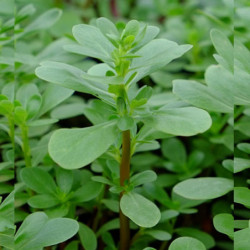- Out-of-Stock


Looking for a nutritious and flavorful option for your dishes? You can't miss the opportunity to try purslane. This incredible plant with bright green and succulent leaves will surprise you with its refreshing and slightly acidic taste. Purslane is known for being an excellent source of vitamins, minerals, and antioxidants that benefit your health. Add it to salads, stews, or stir-fries and enjoy its crunchy texture and delicious flavor.
 Security policy
Security policy
Website built using newest versions, SSL protocols, Secure payments
 Delivery policy
Delivery policy
Receive your order in 24-48h
 Return policy
Return policy
100% Satisfaction guarantee

Guarantee safe & secure checkout
Buying purslane is the perfect choice to add a healthy and flavorful touch to your meals. Purslane, scientifically known as Portulaca oleracea, is an edible herbaceous plant used in both cooking and traditional medicine in various cultures.
Its stems, leaves, flowers, and seeds are edible. It has a mild, slightly acidic flavor, which is why it's sometimes called "purslane," as it's known in some places.
Nutrients: Purslane is an excellent source of nutrients. It contains high levels of vitamin A, vitamin C, vitamin E, vitamin B, as well as minerals such as calcium, magnesium, potassium, and iron.
Omega-3 fatty acids: It's one of the few plant sources of omega-3 fatty acids, which are beneficial for cardiovascular and brain health.
Antioxidants: It contains antioxidants such as flavonoids and betalains, which help fight oxidative stress and reduce the risk of chronic diseases.
Medicinal properties: It's attributed with anti-inflammatory, antioxidant properties, and it has been traditionally used to treat digestive, skin, and immune system problems.
It can be consumed in many ways:
Raw in salad or any other raw presentation.
Cooked, preferably steamed, or sautéed.
Juice: We can extract it from the fresh plant with a blender, or add it to a smoothie.
Fermented in brine: As an infusion, either with fresh or dry plant. The maceration time will be brief.
Another way to consume it is as a dry plant: although fresh is how it preserves all its properties, we can also dry it and then use it for infusions or add it powdered to soups, as a thickener.
Origin: It's believed that purslane is native to Persia (modern-day Iran), but it has spread throughout the centuries worldwide and is found in many regions with temperate and warm climates.
Cultivation: It's a hardy and adaptable plant that grows easily in well-drained soils and sunny areas. It can be grown in pots or in the ground. It's a fast-growing annual plant that produces fleshy green leaves and small yellow flowers.
Harvest Season: It can be harvested for much of the year, although it's usually more abundant in spring and summer.
Common name: Purslane goes by different common names in different parts of the world. For example, in English, it's known as "purslane," in French as "pourpier," and in Spanish, it's called "verdolaga."
Wild plant: Although often cultivated, purslane can also grow wild in many regions, often considered a "weed." However, it's a valuable source of nutrients and has been consumed since ancient times.
Culinary diversity: It's used in a wide variety of dishes around the world, from salads and soups to stews and stir-fries. In some cultures, it's considered a delicacy ingredient appreciated for its slightly acidic flavor and succulent leaves.
Don't wait any longer and discover all the benefits this plant can offer you. Take advantage of the opportunity and buy purslane today!